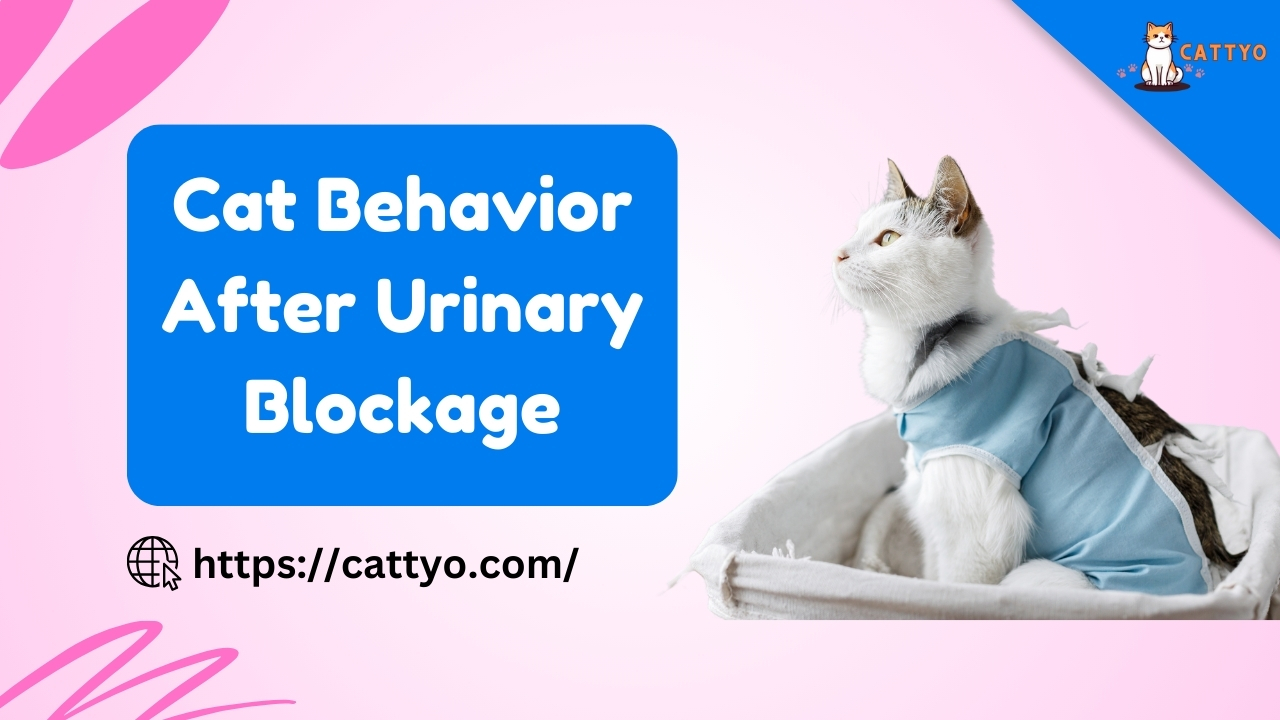Imagine your cat, once energetic and playful, suddenly seems a little… off. They’re avoiding their litter box, licking themselves more than usual, or just sitting quietly in a corner.
If your cat has recently experienced a urinary blockage, these changes in behavior are likely a result of this stressful and potentially life-threatening condition.
Urinary blockages are no small matter. In fact, they can lead to severe health complications, including kidney damage, if left untreated.
As a pet parent, understanding how your cat behaves after experiencing such an episode is essential for ensuring their recovery.
In this article, we’ll explore how urinary blockages affect your cat’s behavior, what changes to look out for, and how to support your furry friend during their recovery process.
What Is a Urinary Blockage in Cats? A Quick Overview
First things first, let’s quickly go over what a urinary blockage is. It happens when a cat’s urethra (the tube that drains urine from the bladder) gets blocked.
This blockage prevents urine from being excreted, which can be incredibly painful for your cat and can even lead to serious health issues like kidney damage or bladder rupture if not treated quickly.
Urinary blockages are most common in male cats due to their narrower urethra, but females can also be affected.
The causes of these blockages can range from urinary stones and crystals to inflammation or infection. In some cases, a blockage may be caused by a combination of factors.
If your cat has had a urinary blockage, it’s crucial to understand that their behavior will likely change during the recovery period. After all, this is a pretty traumatic event for them, both physically and emotionally.
Understanding Urinary Blockage in Cats: A Brief Overview
Before diving into the behavioral changes that follow a urinary blockage, it’s important to first understand what this condition is.
A urinary blockage occurs when the urethra (the tube that carries urine out of the bladder) becomes obstructed, often due to crystals, stones, or inflammation.
This blockage prevents the cat from urinating, leading to painful, dangerous conditions like bladder rupture or kidney failure if not treated promptly.
Male cats, especially those with narrow urethras, are more prone to developing urinary blockages, though females can be affected as well. It is a medical emergency, and veterinary intervention is essential.
How Urinary Blockage Affects Your Cat’s Behavior
When a cat suffers from a urinary blockage, it can be an incredibly painful experience. Cats are masters at hiding discomfort, so it’s important for pet owners to be vigilant in spotting signs.
After the blockage has been cleared (often through catheterization or surgery), your cat will likely exhibit some behavior changes as they recover. Here’s what to expect:
1. Increased Litter Box Avoidance
One of the most immediate signs that your cat has experienced a urinary blockage is a sudden reluctance to use the litter box. After the blockage is cleared, some cats continue to avoid the litter box for a while. This behavior can stem from:
- Discomfort: Even after the blockage is removed, the urethra may be sore or irritated, making the process of urinating painful.
- Anxiety: The trauma of the blockage and any procedures can make your cat anxious about the litter box. They may associate it with pain or discomfort.
- Frequent Urination: After being blocked for an extended period, your cat might try to urinate frequently, but only a small amount may come out each time. This can lead to frustration and further avoidance.
Tip: Offer several clean litter boxes in quiet, low-traffic areas. Ensure the box is easy to access and the litter is gentle on sensitive paws.
2. Increased Grooming and Licking Behavior
If your cat is licking their genital area more than usual, it’s likely a sign that they are experiencing discomfort. After a urinary blockage, your cat may attempt to groom the area in an attempt to soothe any irritation or residual pain.
In some cases, excessive grooming can lead to hair loss or sores. If you notice this, it’s important to monitor your cat closely.
Tip: Provide distraction through interactive toys to keep your cat mentally engaged, reducing the focus on grooming.
3. Lethargy and Decreased Activity Levels
Cats recovering from a urinary blockage often feel worn out. The pain and discomfort from the blockage, as well as any treatments they underwent, can make them feel exhausted. You may notice your cat becoming more lethargic than usual, spending long hours resting or hiding away in a quiet spot.
Lack of energy is common immediately after treatment, but be patient. It could take some time for your cat to feel like their usual self.
Tip: Allow your cat plenty of quiet, restful space to recover. Avoid overwhelming them with activity.
4. Appetite Changes and Weight Fluctuations
It’s not uncommon for cats recovering from a urinary blockage to have changes in appetite. Some cats may experience a loss of appetite, while others may suddenly become ravenous, especially if their metabolism was affected during the blockage.
Tip: Monitor your cat’s food intake closely. If they’re refusing food or eating significantly less, consult your vet to rule out any other health concerns.
How to Help Your Cat During Recovery
Seeing your cat go through behavioral changes can be tough, but there’s a lot you can do to help them through the recovery process. Here are some things you can try to make the process smoother:
1. Keep Their Environment Calm and Stress-Free
Your cat has been through a lot, so creating a quiet, stress-free environment is key. Cats recovering from a urinary blockage often feel anxious, so minimizing loud noises or sudden changes in their environment will help them feel secure.
- Use Feliway: This pheromone-based product mimics natural cat scents and can help reduce anxiety.
- Provide Hiding Spots: Cats love their hideaways. Provide plenty of cozy, safe spaces for your cat to retreat to when they need some downtime.
2. Monitor Their Hydration
Dehydration can be a real issue after a urinary blockage, so make sure your cat has access to plenty of fresh water. If your cat doesn’t seem to drink much, consider offering wet food or using a pet water fountain, which some cats prefer over regular water bowls.
- Encourage Drinking: Place multiple water bowls around your home to encourage your cat to drink more.
3. Gradual Return to Normal Activities
After a period of rest, your cat might start feeling better and want to resume their regular activities. But don’t rush things! Their body still needs time to heal.
- Short Play Sessions: Gradually reintroduce interactive play but keep it gentle to avoid putting too much strain on their body.
4. Regular Vet Check-Ups
After a urinary blockage, your cat will need regular check-ups to ensure that they’re healing properly and that no further blockages are developing. These follow-up visits will help catch any complications early on.
Tip: Keep an eye out for any recurring signs of discomfort or changes in their behavior, and don’t hesitate to consult your vet.
Behavioral Adjustments During Recovery: What to Do as a Pet Parent
As your cat recovers from a urinary blockage, there are several things you can do to help them adjust. Here are a few strategies to ensure they’re as comfortable as possible:
1. Keep Them Hydrated
One of the best things you can do is make sure your cat is staying hydrated. Dehydration can exacerbate urinary issues, and it’s important to encourage your cat to drink water during their recovery. Some cats prefer running water, so a pet water fountain might be helpful.
Tip: Try offering wet food if your cat isn’t drinking enough water. This can also help increase their fluid intake.
2. Prevent Stress and Anxiety
Your cat’s behavior after urinary blockage may include increased anxiety or stress. This can make them more skittish, fearful, or even aggressive. Keep their environment calm and stable, and avoid any drastic changes to their routine. Provide quiet spaces where they can retreat if they feel overwhelmed.
Tip: Use pheromone diffusers or sprays like Feliway to help reduce anxiety.
3. Gradual Reintroduction to Normal Activities
After some time, your cat will likely begin to feel more like themselves. They may start using the litter box again or begin playing with their favorite toys. However, don’t rush things. Gradually reintroduce activities, allowing your cat to adjust at their own pace.
Tip: If your cat was particularly active before the blockage, offer shorter, more frequent play sessions to help them regain strength without overexerting themselves.
When to Seek Further Veterinary Help
While most cats recover well after a urinary blockage, complications can occur. If you notice any of the following, it’s important to consult your veterinarian immediately:
- Persistent Litter Box Avoidance: If your cat continues to avoid the litter box for more than a few days, or seems to be straining to urinate, there could be an underlying issue.
- Bloody Urine: Any blood in your cat’s urine is a sign that something is wrong and needs immediate attention.
- Extreme Lethargy: If your cat is still excessively tired after several days, or refuses to eat or drink, it’s time to check in with your vet.
FAQs About Cat Behavior After Urinary Blockage
Q: How long will it take for my cat’s behavior to return to normal after a urinary blockage?
A: The recovery time can vary depending on the severity of the blockage and the treatment. Some cats bounce back within a few days, while others may take weeks to fully regain their normal behavior.
Q: Can urinary blockages lead to long-term behavioral changes?
A: In most cases, once the cat has fully recovered from the blockage, their behavior should return to normal. However, if there were underlying issues (like bladder stones or infections), behavior might fluctuate until the cause is resolved.
Q: Will my cat need to be on a special diet after the blockage?
A: Often, cats that experience urinary blockages are placed on special diets to prevent future issues, such as prescription urinary food that helps dissolve crystals and promote urinary health.
Q: How long does it take for my cat to recover fully after a urinary blockage?
A: Most cats will start to feel better within a few days, but full recovery might take several weeks. It’s important to monitor them closely and give them plenty of time to rest.
Q: Will my cat’s behavior ever return to normal after the blockage?
A: In most cases, yes! While there may be some residual anxiety or behavioral changes during the healing process, your cat should return to their regular behavior as they recover.
Q: Are urinary blockages common in cats?
A: Unfortunately, yes. Male cats are more prone to urinary blockages, but females can also be affected. It’s important to be aware of the signs and seek prompt veterinary care.
Conclusion: Patience is Key
As a pet parent, it’s crucial to be patient and understanding when your cat is recovering from a urinary blockage. Their behavior may change temporarily, but with proper care and attention, they can return to their happy, healthy self. Remember, if you’re ever uncertain about your cat’s recovery or behavior, don’t hesitate to reach out to your veterinarian for advice.
With your support, your feline friend will soon be back to their usual self—tail high, ready to play and pounce.


